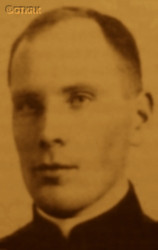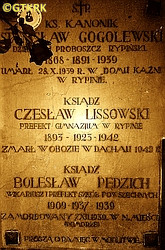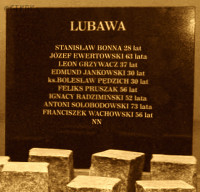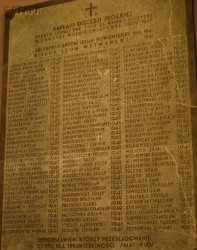Roman Catholic
St Sigismund parish
05-507 Słomczyn
85 Wiślana Str.
Konstancin deanery
Warsaw archdiocese, Poland
full list:
displayClick to display full list

searchClick to search full list by categories
wyświetlKliknij by wyświetlić pełną listę po polsku

szukajKliknij by przeszukać listę wg kategorii po polsku

Martyrology of the clergy — Poland
XX century (1914 – 1989)
personal data
surname
PĘDZICH
forename(s)
Boleslav (pl. Bolesław)
function
diocesan priest
creed
Latin (Roman Catholic) Church RCmore on
en.wikipedia.org
[access: 2014.09.21]
diocese / province
Płock diocesemore on
en.wikipedia.org
[access: 2013.05.19]
date and place
of death
07.12.1939

Lubawatoday: Lubawa urban gm., Iława pov., Warmia‐Masuria voiv., Poland
more on
en.wikipedia.org
[access: 2021.09.02]
details of death
After German invasion of Poland in 09.1939 and start of the World War II, after start of German occupation, arrested by Germans on 20.10.1939 in Rypin — accused by a local German pastor of anti–German stance.
Jailed in VSH Rypin jail in Rypin.
From there on 30.10.1939 moved to the VSH Obory transit camp in Obory monastery.
On 04.12.1939 as a result of „local German complaints” transported back to VSH Rypin jail in Rypin (together with Fr Stanislav Sławiński).
There tortured — beaten „on the barrel”.
Finally on 07.12.1939 taken to Lubawa and there murdered — publically executed in a bland alley by the market square, together with 15 other Polish „hostages” — allegedly drunk Germans shot „blindly”, from a very short distance, at a group of gathered victims.
cause of death
mass murder
perpetrators
Germans
sites and events
Collective responsibility („Hostages”)Click to display the description, VSH OboryClick to display the description, VSH RypinClick to display the description, «Intelligenzaktion»Click to display the description, Reichsgau Danzig‐WestpreußenClick to display the description, Ribbentrop‐MolotovClick to display the description, Pius XI's encyclicalsClick to display the description
date and place
of birth
05.10.1909Birth certification on:
metryki.genealodzy.pl
[access: 2025.03.16]

Nowa Pecynatoday: Długosiodło gm., Wyszków pov., Masovia voiv., Poland
more on
en.wikipedia.org
[access: 2021.12.18]
parents
PĘDZICH Stanislav
🞲 ?, ? — 🕆 ?, ?

DROZD Bronislava
🞲 ?, ? — 🕆 ?, ?
baptism
17.10.1909Birth certification on:
metryki.genealodzy.pl
[access: 2025.03.16]

Długosiodłotoday: Długosiodło gm., Wyszków pov., Masovia voiv., Poland
more on
en.wikipedia.org
[access: 2021.12.18]
Assumption of the Blessed Virgin Mary RC church
presbyter (holy orders)
ordination
06.06.1936

Płocktoday: Płock city pov., Masovia voiv., Poland
more on
en.wikipedia.org
[access: 2021.12.18]
Assumption of the Blessed Virgin Mary RC cathedral churchmore on
en.wikipedia.org
[access: 2025.03.14]
positions held
1936 – 1939
prefect — Rypintoday: Rypin gm., Rypin pov., Kuyavia‐Pomerania voiv., Poland
more on
en.wikipedia.org
[access: 2021.12.18] ⋄ public schools ⋄ Holy Trinity RC parish ⋄ Rypintoday: Rypin gm., Rypin pov., Kuyavia‐Pomerania voiv., Poland
more on
en.wikipedia.org
[access: 2021.12.18] RC deanery
1936
vicar — Osiekform.: Osiek Rypiński
today: Osiek gm., Brodnica pov., Kuyavia‐Pomerania voiv., Poland
more on
en.wikipedia.org
[access: 2021.12.18] ⋄ Assumption of the Blessed Virgin Mary RC parish ⋄ Rypintoday: Rypin gm., Rypin pov., Kuyavia‐Pomerania voiv., Poland
more on
en.wikipedia.org
[access: 2021.12.18] RC deanery
till 1936
student — Płocktoday: Płock city pov., Masovia voiv., Poland
more on
en.wikipedia.org
[access: 2021.12.18] ⋄ philosophy and theology, Theological Seminary
others related
in death
SŁAWIŃSKIClick to display biography Stanislav, BATKOClick to display biography Alexander, BORZYSZKOWSKIClick to display biography Joseph, BUSZTAClick to display biography Anthony (Fr Simon), FLACZYŃSKIClick to display biography Francis, GAJEWSKIClick to display biography Vladislav, GOGOLEWSKIClick to display biography Stanislav, GRABOWSKIClick to display biography Sigismund, HINZClick to display biography Thaddeus, JARANOWSKIClick to display biography Constantine Stanislav, KACZOROWSKIClick to display biography Michael, MAKOWSKIClick to display biography Paul (Fr Bruno), MALINOWSKIClick to display biography Constantine Peter, MATEUSZCZYKClick to display biography Theodore, NOWAKClick to display biography Stanislav Zeno, OSTROWSKIClick to display biography Francis Xavier, PRABUCKIClick to display biography Boleslav Rock, PRYBAClick to display biography Leo Simon, RADTKEClick to display biography Steven Boleslav, WALCZAKClick to display biography Mary (Sr Theodosia), WILAMOWSKIClick to display biography Alexander, ŻUCHOWSKIClick to display biography Vaclav
sites and events
descriptions
Collective responsibility („Hostages”): A criminal practice implemented by the Germans in the occupied territories of Poland, applied from the very first day of World War II. At its core was an appointment and public announcement of a list of names of selected people whose lives depended on absolute compliance with German orders. Any violation of these ordinances, by any person, regardless of the circumstances, resulted in the murder of the designated „hostages”. In the first days of the war and occupation, it was used i.a. by the German Wehrmacht army to prevent acts of continuation of the defense by the Poles. Later, especially in the German‐run General Governorate, it was part of the official policy of the occupation authorities — collective responsibility for any acts of resistance to the occupier's practices. For the life of one German, even if death was due to customary reasons, the Germans carried out executions from a dozen to even a hundred Poles previously designated as „hostages”.
VSH Obory: German Germ. Volksdeutscher Selbstschutzhaft (Eng. Volksdeutscher Selbstschutz custody) VSH for the clergy of the Dobrzyń region (in Płock diocese) and neighbouring parishes of Chełmno diocese, established on 30.10.1939 by Germans, members of the genocidal paramilitary Germ. Volksdeutscher Selbstschutz formation — the decision to create Selbstschutz in the Polish lands occupied by German troops was made in Berlin on 08‐10.09.1939 at a conference headed by Reichsführer‐SS Heinrich Himmler (the formal order bears the date 20.09.1939), and the chaotically formed units were directly subordinated to the officers of the genocidal SS organization — Germ. Geheime Staatspolizei (Eng. State Secret Police), i.e. Gestapo, in Carmelite Fathers OCarm monastery in Obory village c. 18 km form Golub–Dobrzyń. Till 22.02.1940 in a Carmelite fathers’ convent Germans held captive — in extremely difficult conditions, in the middle of a very hard winter, without heating or outer clothes, on unchanged straw in cold cells, without food (saved only by the local residents who shared with them their own food), forced to perform forced slave labor — 52 Catholic priest and 3 nuns. Almost all (apart from two, denounced by local German population, were driven out of the camp and murdered in public mass execution of Poles) were deported to concentration camps: initially KL Stutthof and KL Sachsenhausen. Most of them perished there. (more on: pl.wikipedia.orgClick to attempt to display webpage
[access: 2013.08.17], www.obory.com.plClick to attempt to display webpage
[access: 2012.12.28])
VSH Rypin: German Germ. Volksdeutscher Selbstschutzhaft (Eng. Volksdeutscher Selbstschutz custody) VSH for the inhabitants of the Dobrzyń region founded in 09/10.1939 by Germans, members of the genocidal paramilitary Germ. Volksdeutscher Selbstschutz formation — the decision to create Selbstschutz in the Polish lands occupied by German troops was made in Berlin on 08‐10.09.1939 at a conference headed by Reichsführer‐SS Heinrich Himmler (the formal order bears the date 20.09.1939), and the chaotically formed units were directly subordinated to the officers of the genocidal SS organization. Rypin the Germans captured on 07.09.1939. Based on the German minority of the region — incorporated directly into Germany in 10.1939 as the Germ. Regierungsbezirk Marienwerder (Eng. Kwidzyn Regency) of the new province Germ. Reichsgau Danzig–Westpreußen (Eng. Reich District of Gdańsk–West Prussia) — the VS structure was organized by the SS officer who arrived with the invaders. The arrest was organized in former Polish State Police station in Rypin, at the same time becaming an outpost of the Germ. Geheime Staatspolizei (Eng. Secret State Police), i.e. Gestapo. C. 1,100‐2,000 Poles were imprisoned and tortured there (the building started to be known as the „House of Torment”). Among the arrested were c. 96 Polish teachers and education workers (they were summoned to the building of the Rypin County Office to „participate in an educational conference”, and promptly detained), landowners, officials, lawyers, doctors, students, members of organizations promoting Polishness, peasants and workers respected in their communities, high school students, as well as at least 18 Catholic priests. The dogs were set on them, nails were driven into their backs, their mouths were filled with plaster, the heads of small children were smashed against walls, and arrested women were raped. Pregnant women were murdered. The victims' gold teeth were pulled out (by a local Ukrainian collaborating with the Germans). Most of them — as part of «Intelligenzaktion», aimed at extermination of Polish intelligentsia and ruling classes — were murdered in the detention facility, in Rypin itself or in the nearby Skrwileńskie and Rusinowskie forests. (more on: pl.wikipedia.orgClick to attempt to display webpage
[access: 2013.08.17])
«Intelligenzaktion»: German: «Intelligenzaktion» (English: „Intelligence Action”) — a German program of extermination of the Polish elite, mainly the intelligentsia and leadership layers, carried out from the beginning of the occupation in w 09.1939 to 04.1940, mainly in territories directly annexed to Germany, but also in the so‐called Germ. Generalgouvernement (Eng. General Governorate), where it was called «AB‐aktion». In the first phase, immediately after the beginning of the German occupation, during military operations carried out by the Germ. Wehrmacht (Eng. Armed Forces) and the genocidal units of the Germ. Einsatzgruppen (Eng. Operational Groups) of the Germ. Sicherheitspolizei (Eng. Security Police), i.e. SiPo, and Germ. Sicherheitsdienst des Reichsführers SS (Eng. Security Service of the Reichsführer SS), i.e. SD, organized by the Germ. Reichssicherheitshauptamt (Eng. Reich Main Security Office), i.e. RSHA, which followed the troops, carried out under the Germ. Unternehmen „Tannenberg” (Eng. Operation „Tannenberg”) — based on the so‐called Germ. Sonderfahndungsliste (Eng. Special Wanted Lists), i.e. proscription lists of Poles considered particularly dangerous to the Third Reich, prepared by the Zentralstelle II/P (Polen) unit of the German RSHA. Later, implemented by the German civilian occupation authorities and the genocidal unit of the Germ. Volksdeutscher Selbstschutz (Eng. Ethnic Germans Self‐Defense), whose members were Germ. Volksdeutsche (Eng. Ethnic Germans), i.e. representatives of the German minority in Poland. According to various sources, these lists, at the beginning of 09.1939, could have contained the details of 61,000—88,000 „dangerous” Poles — although these figures cannot be confirmed. In total, during this genocide, c. 50,000 teachers, Catholic priests, representatives of the landed gentry, freelancers, social and political activists, and retired military personnel were systematically and methodically murdered. Another 50,000 were sent to concentration camps, where only a negligible percentage survived. (more on: en.wikipedia.orgClick to attempt to display webpage
[access: 2014.10.04])
Reichsgau Danzig‐Westpreußen: After the Polish defeat in the 09.1939 campaign, which was the result of the Ribbentrop‐Molotov Pact and constituted the first stage of World War II, and the beginning of German occupation in part of Poland (in the other, eastern part of Poland, the Russian occupation began), the Germans divided the occupied Polish territory into five main regions (and a few smaller). The largest one was transformed into Germ. Generalgouvernement (Eng. General Governorate), intended exclusively for Poles and Jews and constituting part of the so‐called Germ. Großdeutschland (Eng. Greater Germany). Two were added to existing German provinces. From two other separate new provinces were created. Vistula Pomerania region was one of them, incorporated into Germany on 08.10.1939, by decree of the German leader Adolf Hitler (formally came into force on 26.10.1939), and on 02.11.1939 transformed into the Germ. Reichsgau Danzig‐Westpreußen (Eng. Reich District of Gdańsk‐West Prussia) province, in which the law of the German state was to apply. The main axis of the policy of the new province, the territory of which the Germans recognized as the Germ. „Ursprünglich Deutsche” (Eng. „natively German”), despite the fact that 85% of its inhabitants were Poles, was Germ. „Entpolonisierung” (Eng. „Depolonisation”), i.e. forced Germanization. C. 60,000 Poles were murdered in 1939‐1940, as part of the Germ. „Intelligenzaktion”, i.e. extermination of Polish intelligentsia and ruling classes, in c. 432 places of mass executions — including c. 220 Polish Catholic priests. The same number were sent to German concentration camps, from where few returned (over 300 priests were arrested, of whom c. 130 died in concentration camps). C. 124,000‐170,000 were displaced, including c. 90,000 to the Germ. Generalgouvernement. Poles were forced en masse to sign the German nationality list, the Germ. Deutsche Volksliste DVL. Polish children could only learn in German. It was forbidden to use the Polish language during Catholic Holy Masses and during confession. Polish landed estates were confiscated..To further reduce the number of the Polish population, Poles were sent to forced labor deep inside Germany. The remaining Poles were treated as low‐skilled labor, isolated from the Germans and strictly controlled — legally, three or three of them could only meet together, even in their own apartments. Many were conscripted into the German Wehrmacht army. After the end of hostilities of World War II, the overseer of this province, the Germ. Reichsstatthalter (Eng. Reich Governor) and the Germ. Gauleiter (Eng. district head) of the German National Socialist Party, Albert Maria Forster, was executed. (more on: en.wikipedia.orgClick to attempt to display webpage
[access: 2024.06.24])
Ribbentrop‐Molotov: Genocidal Russian‐German alliance pact between Russian leader Joseph Stalin and German leader Adolf Hitler signed on 23.08.1939 in Moscow by respective foreign ministers, Mr. Vyacheslav Molotov for Russia and Joachim von Ribbentrop for Germany. The pact sanctioned and was the direct cause of joint Russian and German invasion of Poland and the outbreak of the World War II in 09.1939. In a political sense, the pact was an attempt to restore the status quo ante before 1914, with one exception, namely the „commercial” exchange of the so‐called „Kingdom of Poland”, which in 1914 was part of the Russian Empire, fore Eastern Galicia (today's western Ukraine), in 1914 belonging to the Austro‐Hungarian Empire. Galicia, including Lviv, was to be taken over by the Russians, the „Kingdom of Poland” — under the name of the General Governorate — Germany. The resultant „war was one of the greatest calamities and dramas of humanity in history, for two atheistic and anti‐Christian ideologies — national and international socialism — rejected God and His fifth Decalogue commandment: Thou shall not kill!” (Abp Stanislav Gądecki, 01.09.2019). The decisions taken — backed up by the betrayal of the formal allies of Poland, France and Germany, which on 12.09.1939, at a joint conference in Abbeville, decided not to provide aid to attacked Poland and not to take military action against Germany (a clear breach of treaty obligations with Poland) — were on 28.09.1939 slightly altered and made more precise when a treaty on „German‐Russian boundaries and friendship” was agreed by the same murderous signatories. One of its findings was establishment of spheres of influence in Central and Eastern Europe and in consequence IV partition of Poland. In one of its secret annexes agreed, that: „the Signatories will not tolerate on its respective territories any Polish propaganda that affects the territory of the other Side. On their respective territories they will suppress all such propaganda and inform each other of the measures taken to accomplish it”. The agreements resulted in a series of meeting between two genocidal organization representing both sides — German Gestapo and Russian NKVD when coordination of efforts to exterminate Polish intelligentsia and Polish leading classes (in Germany called «Intelligenzaktion», in Russia took the form of Katyń massacres) where discussed. Resulted in deaths of hundreds of thousands of Polish intelligentsia, including thousands of priests presented here, and tens of millions of ordinary people,. The results of this Russian‐German pact lasted till 1989 and are still in evidence even today. (more on: en.wikipedia.orgClick to attempt to display webpage
[access: 2015.09.30])
Pius XI's encyclicals: Facing the creation of two totalitarian systems in Europe, which seemed to compete with each other, though there were more similarities than contradictions between them, Pope Pius XI issued in 03.1937 (within 5 days) two encyclicals. In the „Mit brennender Sorge” (Eng. „With Burning Concern”) published on 14.03.1938, condemned the national socialism prevailing in Germany. The Pope wrote: „Whoever, following the old Germanic‐pre‐Christian beliefs, puts various impersonal fate in the place of a personal God, denies the wisdom of God and Providence […], whoever exalts earthly values: race or nation, or state, or state system, representatives of state power or other fundamental values of human society, […] and makes them the highest standard of all values, including religious ones, and idolizes them, this one […] is far from true faith in God and from a worldview corresponding to such faith”. On 19.03.1937, published „Divini Redemptoris” (Eng. „Divine Redeemer”), in which criticized Russian communism, dialectical materialism and the class struggle theory. The Pope wrote: „Communism deprives man of freedom, and therefore the spiritual basis of all life norms. It deprives the human person of all his dignity and any moral support with which he could resist the onslaught of blind passions […] This is the new gospel that Bolshevik and godless communism preaches as a message of salvation and redemption of humanity”… Pius XI demanded that the established human law be subjected to the natural law of God , recommended the implementation of the ideal of a Christian state and society, and called on Catholics to resist. Two years later, National Socialist Germany and Communist Russia came together and started World War II. (more on: www.vatican.vaClick to attempt to display webpage
[access: 2023.05.28], www.vatican.vaClick to attempt to display webpage
[access: 2023.05.28])
sources
personal:
www.obory.com.plClick to attempt to display webpage
[access: 2012.12.28], mazowsze.hist.plClick to attempt to display webpage
[access: 2012.12.28], metryki.genealodzy.plClick to attempt to display webpage
[access: 2025.03.16], www.straty.plClick to attempt to display webpage
[access: 2015.04.18]
bibliographical:
„Płock diocese clergy martyrology during II World War 1939‐1945”, Fr Nicholas Marian Grzybowski, Włocławek–Płock 2002
„Lubawa County Biographical Lexicon 1244‐2000”, George Szews, 2000
original images:
www.facebook.comClick to attempt to display webpage
[access: 2021.12.19], miejscapamiecinml.blogspot.comClick to attempt to display webpage
[access: 2015.05.09], miejscapamiecinml.blogspot.comClick to attempt to display webpage
[access: 2015.05.09]
LETTER to CUSTODIAN/ADMINISTRATOR
If you have an Email client on your communicator/computer — such as Mozilla Thunderbird, Windows Mail or Microsoft Outlook, described at WikipediaPatrz:
en.wikipedia.org, among others — try the link below, please:
LETTER to CUSTODIAN/ADMINISTRATORClick and try to call your own Email client
If however you do not run such a client or the above link is not active please send an email to the Custodian/Administrator using your account — in your customary email/correspondence engine — at the following address:

giving the following as the subject:
MARTYROLOGY: PĘDZICH Boleslav
To return to the biography press below:
 Click to return to biography
Click to return to biography












